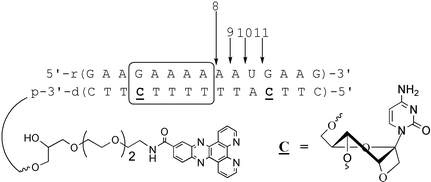Antisense oligonuclotides with oxetane-constrained cytidine enhance heteroduplex stability, and elicit satisfactory RNase H response as well as showing improved resistance to both exo and endonucleases†
Abstract
Antisense ![[C with combining low line]](https://www.rsc.org/images/entities/b_char_0043_0332.gif) modifications [1′,2′-oxetane constrained
modifications [1′,2′-oxetane constrained ![[T with combining low line]](https://www.rsc.org/images/entities/b_char_0054_0332.gif) -modified AONs, for their antisense potentials by targeting to a 15mer complementary RNA. Although the
-modified AONs, for their antisense potentials by targeting to a 15mer complementary RNA. Although the ![[C with combining low line]](https://www.rsc.org/images/entities/b_char_0043_0332.gif) modified mixmer AONs show ∼3 °C drop per modification in melting temperature (Tm) of their hybrid AON–RNA duplexes, they are found to be good substrates for RNase H, in comparison with the native AON–RNA duplex. An AON with double
modified mixmer AONs show ∼3 °C drop per modification in melting temperature (Tm) of their hybrid AON–RNA duplexes, they are found to be good substrates for RNase H, in comparison with the native AON–RNA duplex. An AON with double ![[C with combining low line]](https://www.rsc.org/images/entities/b_char_0043_0332.gif) modifications along with 3′-DPPZ (
modifications along with 3′-DPPZ (![[C with combining low line]](https://www.rsc.org/images/entities/b_char_0043_0332.gif) modified AON–RNA duplexes as well as double
modified AON–RNA duplexes as well as double ![[C with combining low line]](https://www.rsc.org/images/entities/b_char_0043_0332.gif) modifications along with 3′-DPPZ have catalytic activities (kcat) close to the native. However, the RNase H binding affinity (1/Km) showed a slight decrease with increase in the number of modifications, which results in less effective enzyme activity (kcat/Km) for
modifications along with 3′-DPPZ have catalytic activities (kcat) close to the native. However, the RNase H binding affinity (1/Km) showed a slight decrease with increase in the number of modifications, which results in less effective enzyme activity (kcat/Km) for ![[C with combining low line]](https://www.rsc.org/images/entities/b_char_0043_0332.gif) modified AON–RNA duplexes. All
modified AON–RNA duplexes. All ![[C with combining low line]](https://www.rsc.org/images/entities/b_char_0043_0332.gif) modified AONs (with 3′-DPPZ), as in the
modified AONs (with 3′-DPPZ), as in the ![[T with combining low line]](https://www.rsc.org/images/entities/b_char_0054_0332.gif) counterpart, showed an enhanced tolerance towards the endonuclease and exonuclease degradation compared to the native (the
counterpart, showed an enhanced tolerance towards the endonuclease and exonuclease degradation compared to the native (the


 Please wait while we load your content...
Please wait while we load your content...